An interview with ringtailed lemur expert Alison Jolly
An interview with ringtailed lemur expert Alison Jolly
Rhett A. Butler, mongabay.com
October 6, 2008
|
|
Madagascar has more than 100 types of lemurs, but the most famous species is the ringtailed lemur, a primate found widely in the southern part of the Indian Ocean island.
The world’s leading expert on ringtailed lemurs is Alison Jolly, presently a Visiting Scientist at the University of Sussex in the UK. Since arriving on the Indian Ocean island in 1963, Jolly has documented the behavior and population dynamics of ringtailed lemurs in Berenty, a small private reserve of gallery forest amid a sea of desert-like spiny forest in southern Madagascar.
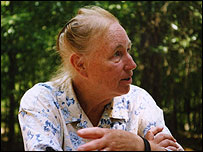 Alsion Jolly. Image courtesy of the BBC |
Jolly has authored several books on her experiences and research, including Lords & Lemurs, a popular account of Berenty’s history; Lucy’s Legacy, which offers a unique take on the sociobiology of humans; Ringtailed Lemur Biology, which presents the ecology and behavior of ringtails; and two children’s books, Ako the Aye-Aye and Bitika the Mouselemur.
Jolly has received many awards for her research and conservation work, but one of her dearest distinctions came in 2006 when a new species of mouse lemur (Microcebus jollyae) was named in her honor.
In an interview with mongabay.com in the fall of 2008, Jolly discussed lemurs and conservation in Madagascar.
AN INTERVIEW WITH ALISON JOLLY
Mongabay: What led you to study lemurs in Madagascar?
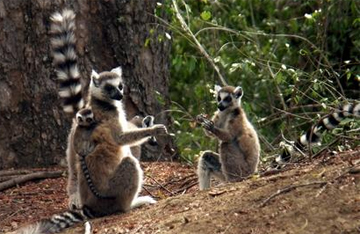 Ringtailed lemurs in Berenty |
Alison Jolly:
Luck, like many people’s careers. A professor at Yale, John Buettner-Janusch, brought the first big US collection of many species of prosimian to Yale–it later became the nucleus of the Duke Lemur Center. I was a grad student, and I was hooked–not just because lemurs are cute, but mainly because there is such a variety of kinds of animals–fast or slow moving, insect- or fruit-eating, diurnal, nocturnal…you name it. Of course they are also all cute!
Mongabay: Your focal species, the ringtailed lemur, has unusual social behavior relative to most primates, in that groups are dominated by females. How has your work on the demography of ringtails influenced your broader thoughts on the evolution of social behavior?
Alison Jolly:
Actually, female dominance in lemurs has never been fully explained. Many of the 80-some lemur species are female-dominant, others more equal. No lemurs are male-dominant which is the common case for other primates and other mammals. Ringtails in particular have the kind of multi-male, multi-female society that we teach in the textbooks should lead to male dominance. They didn’t read the textbooks.
Mongabay: What are some of the changes you’ve seen in terms of conservation since you started working in Madagascar since the mid-1960s? Is protected area management more accommodating of the needs of local communities?
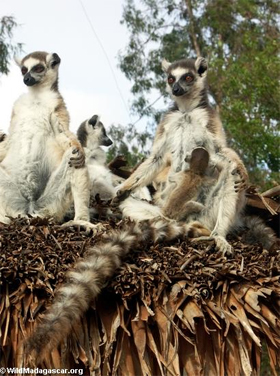 Ringtailed lemurs in Berenty |
Alison Jolly:
Huge changes, from thinking that conservation is a foreign plot to steal people’s land to thinking that it is essential for the people’s future. President Marc Ravelomanana announced in 2003 that the amount of preserved area should be tripled, but with the new zones managed with and by villagers, not just the forest service.
Mongabay: Berenty provides a sort of special case for conservation in that it is a private reserve. Do you see Berenty as an exception in terms of its success or do you think private reserves can offer some advantages over national parks in Madagascar?
Alison Jolly:
Berenty is not just private, but exceptional in all ways–owned by a family who have supported conservation through three generations. Good management doesn’t come from whether a place is public or private, it comes from vision, adequate funding, and courage.
Mongabay: What are some of the biggest challenges to conservation in Madagascar?
Alison Jolly:
Climate change and poverty. I put climate change first. Any Malagasy peasant can tell George Bush or Sarah Palin about the effects of drought and cyclones–though they don’t want to hear.
Mongabay: What is your outlook for the ringtailed lemur? Does it adapt well to human-modified habitat? Will climate change pose a threat to the species?
Alison Jolly:
Ringtails are tough as old boots. As long as there is any forest they can survive. But climate change hammers people who then hammer the forest.
Mongabay: Can ringtailed lemur habitat such as the spiny forest be restored or will it regenerate on its own?
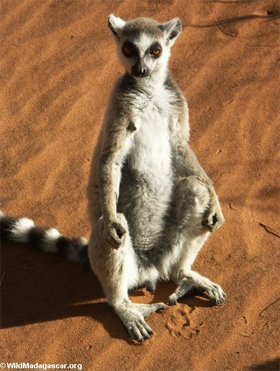 Ringtailed lemur in Berenty |
Alison Jolly:
It regenerates, but slowly. It can also be replanted. However, people have to decide they want it.
Mongabay: What can people in the United States and Europe do to support conservation in Southwestern Madagascar?
Alison Jolly:
Directly? Send money. Indirectly? Teach about Madagascar in schools and videos, and why turning off a light-bulb (or a coal mine) in the US can help a Malagasy farmer to help the forests.
Mongabay: Do you have any advice for aspiring researchers who would like to work in Madagascar?
Alison Jolly:
Come! But remember that if you do, you are a guest, and your main aim is to help Malagasy scientists do the work you’d like to do too.
- Lords & Lemurs
- Lucy’s Legacy
- Ringtailed Lemur Biology, which presents the ecology and behavior of ringtails; and two children’s books, Ako the Aye-Aye and Bitika the Mouselemur.
RELATED INTERVIEWS
 |
conservation is saving lemurs and helping people in Madagascar
(5/7/2007) Madagascar, an island nation that lies off the coast of southeastern Africa, has long been famous for its unique and diverse species of wildlife, especially lemurs–primates found nowhere else on the planet. In recent years, the island country has also become world-renowned for conservation efforts that are succeeding in spite of extraordinary pressures from a poor population that relies heavily on forest burning for basic subsistence. A large part of this success is due to the early efforts of Patricia Wright, a primatologist who has been working in the country for more than 20 years. Wright led the effort to launch the country’s leading protected area and helped Madagascar become a leading global example of conservation despite its economic adversity.
 |
Lemurs at risk due to invasion of feral beasts, global warming
(2/7/2007) The lemurs of Madagascar are among the world’s most threatened primates. Extensive habitat destruction, hunting, and the introduction of alien species have doomed dozens of species to extinction since humans first arrived on the island within the past 2000 years. Most of the casualties were Madagascar’s largest lemurs — today the biggest lemur is but a fraction of the gorilla-sized giants that once ruled the island. Despite this relative impoverishment of megafauna, Madagascar still boasts nearly 90 kinds of lemurs, all of which are unique to the island (save one species that was probably introduced to some nearby islands). Lemurs display a range of unusual behvaiors from singing like a whale (the indri) to sashaying across the sand like a ballet dancer (the sifaka). Interest in lemurs has helped Madagascar become a global conservation priority, though they are still at risk. Continued deforestation, scattered hunting, and looming climate change all pose significant threats to some lemur populations. One largely unexamined threat comes from introduced species such as the Indian civet and mongoose, but especially dogs and cats that have become feral.
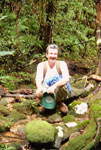 |
Lemur conservation in Madagascar requires poverty alleviation initiatives
(11/5/2006) Madagascar, an island larger than France that lies off the southeastern coast of Africa, is perhaps best known for its lemurs–primates that look something like a cat crossed with a squirrel and a dog. Lemurs, which are found naturally only in Madagascar, serve as a charismatic representation of the island’s biodiversity and its problems. Since the arrival of humans some 2000 years ago from southeast Asia, Madagascar has lost all of its mega fauna and more than 90 percent of its wildlands. Today forest clearing for agriculture and hunting continues to put lemurs and other endemic species at risk. The good news is that because of Madagascar’s biodiversity, the island has become a top priority for global conservation. At the forefront of these efforts is the Madagascar Fauna Group (MFG), an international consortium of zoos and related organizations that work to protect Madagascar’s wildlife and ecosystems, and the Duke University Lemur Center, the one of the world’s leading lemur research facilities. Charlie Welch, currently a research scientist at the Duke University Lemur Center, recently answered some questions on his experiences in lemur conservation. Welch, along with his wife Andrea Katz, has worked in Madagascar for 17 years and helped transform conservation efforts in the country.
Ringtailed lemur photos





























































